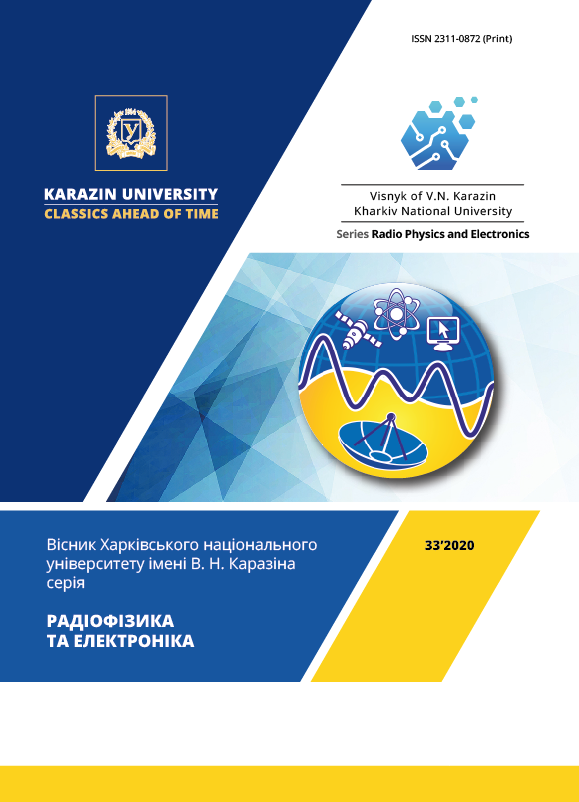Combinational frequencies of HF doppler radar signals in the PC1 geomagnetic pulsation range
Abstract
Urgency. The urgency of this work is determined by the necessity of studying MHD waves originating from various sources within the Earth–atmosphere–ionosphere– magnetosphere system and arriving at ionospheric heights.
The object of research. A matter of this study is ionospheric disturbances that accompanied geomagnetic pulsations during the dawn terminator on 23–24 March 2010.
Purpose of Work. The present work was aimed at revealing short-period ionospheric disturbances in the Pc1 micropulsation frequency range (1–5-Hz) and at investigating their spectral content.
Techniques and Methotology. The dynamic spectra of the variations under study were obtained with the HF Doppler radar.
Results. The ionospheric disturbances have been shown to arise mainly at combinational frequencies. The durations of such disturbances have been estimated to be of the order of one minute, and the disturbance frequencies 0.7 Hz, 1.5 Hz, and 2.5 Hz. The quasi-periodic interference in the 1–5-Hz frequency band has been detected to persist for over one-half hour to a few hours. Based on the model of the signal modulated by ULF waves in the ionosphere, the appearance of constructive interference at combinational frequencies has been validated. The intercomparisons of the variations obtained using the spectrograms and the known models for the phase-modulated signals have been made. A model for the amplitude- and phase-modulated signal reflected from the ionosphere has been developed, and the signal basic parameters have been determined.
Conclusions. The HF Doppler sounding can be a means for studying ionospheric disturbances in the Pc1 geomagnetic pulsation range. During the study of time variations of the Doppler frequency shift during the spring equinox, the following results were found. The period of ionospheric perturbations reached 0.2–1 s, their duration varied from 1 min to more than 10 min. A noticeable increase in the amplitude of the beat is detected, which may be a sign of the appearance of lateral maxima in the Doppler spectra. The presence of oscillations in the frequency range of the first harmonic of the spectral resonance system of the ionospheric Alfvén resonator is established. Long-term ionospheric perturbations have a linearly increasing frequency of filling the wave packet. The rate of frequency change is close to 10–3 Hz/s.
Downloads
References
Alperovich LS, Fedorov EN. Hydromagnetic Waves in the Magnetosphere and the Ionosphere, Series: Astrophysics and Space Science Library. Dordrecht: Springer, 2007. XXIV+426 p. https://doi.org/10.1007/978-1-4020-6637-5
The Space Model. Volume 1. Physical Conditions in Space. Moscow, Russia: KDU, 2007. 872 p. [In Russian].
Pilipenko VA. Resonance Effects of ULF Wave Fields in the Near-Earth Space, Extended Abstract of Doctoral (Phys.–Math.) Dissertation. Moscow: Schmidt IPhE, IRS RAN, 2007, 241 p. [In Russian].
Gershman BN, Eruhimov LM, Yashin YuYa. Wave of the phenomenon in an ionosphere and space plasma. Moscow: Science, 1984. 392 p. [In Russian].
Pilipenko VA, Fedorov EN, Teramoto M, Yumoto K. The mechanism of mid-latitude Pi2 waves in the upper ionosphere as revealed by combined Doppler and magnetometer observations. Ann. Geophys. 2013;31:689–695. https://doi.org/10.5194/angeo-31-689-2013
Pushin VF, Chernogor LF. Spectral Analysis of Reference Signal and of HF Signal Reflected from the Ionosphere Beats. Radio Phys. Radio Astron. 2014;19(2):160–169 [In Russian]. https://doi.org/10.15407/rpra19.02.160
Pushin VF, Chernogor LF. Detecting of Quasi-Periodic Oscillations in the Ionosphere within the Acoustic Gravity Waves Range. Radio Phys. Radio Astron. 2012;17(4):333–343 [In Russian]. http://rpra-journal.org.ua/index.php/ra/article/view/627
Baskakov SI. Radiotechnical Circuits and Signals. Moscow, Russia: Vysshaya shkola, 2000. 462 p. [In Russian].
Afraimovich EL. Interferential Methods of Ionosphere Sounding. Moscow: Nauka; 1982. 198 p. [In Russian].
Obayashi T. Hydromagnetic whistlers. J. Geophys. Res. 1965;70(5):1069–1078. https://doi.org/10.1029/JZ070i005p01069
Akasofu S.-I, Chapman S. Solar–Terrestrial Physics. London: Oxford U.P., 1972. XXIII, 901 p.




